It might surprise many investors to know that despite the violent stock market correction over the last few weeks, the S&P 500 index remains above the trough made during the late 2018 decline. Recession fears during Q4 2018 led to a 20.2% bear market from peak to trough over a three-month period, resulting in an intra-day low for the index of 2,346.
Given that 2019 corporate profits were only modestly above 2018 levels, and considering that the economic weakness from COVID-19 is tangible and not just a “growth scare” (like 2018) market watchers who believe a drop back to that 2,346 is possible, or even likely, do not seem out of line to me. Even at this week’s low point (2,478) it would mean another 5% lower and a full 31% drop from the February market peak.
So if the market today is still above the 2018 low, how does it compare to recent years’ lows? I decided to take a look and the data really sheds light on how far the bull market had come before the novel strain of coronavirus crashed the party.
Below you will see the yearly low for the S&P 500 going back to 2014. I have included the peak-to-trough decline in percentage terms, assuming the current bear market reaches each of those price levels.
Despite an enormous drawdown in 2020, the market remains above the December 2018 lows.
While the percentage drops are severe, it is interesting that even a 34% decline only takes us back to 2017 levels. While that might not sooth investors’ anxiety at the moment, having some context about where we have been does serve to reinforce the long-term equity market trends we have endured during the latest bull market.
I suspect we would see material buying pressure if the S&P 500 dipped down to the low points of 2017 and 2018, unless the virus was truly getting out of control even after governments around the globe took strong and decisive steps to mitigate its spread.
*****
The next logical question to me is what the valuations were at each of these market’s troughs, which can possibly shed some light as to the ultimate magnitude of the current bear market. Below is a chart that shows the P/E ratio on the S&P 500 at each of the low points shown above. I used the actual full year profit figure for each respective year (e.g. the 2014 P/E reflects the low price no matter when during the year it occurred, paired with actual full year 2014 earnings).
Based on the last 5 years, buyers tend to jump in whenever the market P/E nears 15x.
I have heard a lot of commentary in recent days about how the market might actually be more expensive now than it was a month ago, despite a 25-30% market decline. Their reasoning is that earnings are likely to fall dramatically in 2020. For instance, at the high near 3,400 on the S&P 500 stocks fetched 21.6x trailing earnings. However, if earnings fall 25% this year, the S&P at 2,600 would trade at 22.2x earnings.
I find that argument bizarre. The stock market is forward-looking and during a recession really doesn’t trade based on real-time earnings because those figures are depressed and temporary. I much prefer to use actual 2019 earnings to value the market right now, since we don’t know what 2020 profits will look like and they likely won’t stay depressed for very long. While we also don’t know what 2021 earnings will be, a good starting point in my view would be 2019, if we think the world will normalize again sometime within the next 12 months.
At any rate, if we take 2019 S&P operating profits of $157 and use a 15x multiple, we arrive at a level of 2,355. That level just happens to be right at the December 2018 low (2.346) and 31% below the 2020 all-time high. We will see if that kind of level brings out buyers in force in the coming days and weeks. I would guess the virus pandemic/economy would have to get really bad to materially break those levels for an extended period, but that is only an educated guess and prices can pretty much touch any level on any given day.







